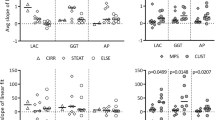Summary
In this study, we tested a new artificial liver device using liver pieces in 8-h hemoperfusion of comatous porcine blood and compared two alternative tissue preparations. Acute hepatic coma in the pigs was induced by complete devascularization of the liver. The animals were killed in stage IV coma (15–25 h after the operation), and 1 1 blood was perfused over 200 g fresh or DMSO-preserved liver cubes. After the devascularization GOT, GPT, GLDH, AP, LDH, SDH, bilirubin, free fatty acid, and bile acid levels in serum increased progressively. Ammonia concentrations underwent a rapid increase in the first 9 h of coma development from 126.0 ± 9.9 to 321.9 ± 62.2 µmol/l. Most of the amino acids in serum were elevated and molar ratio of BCAA/AAA declined from 3.87 ± 0.79 to 0.92 ± 0.24.
In the course of hemoperfusion ammonia was removed from the perfusate to 71% of the initial values using fresh and to 39% using preserved tissue. Correspondingly, there was an increase in urea concentrations. Amino acid metabolism was ameliorated during the perfusion; Fischer's quotient increased from 0.91 ± 0.15 to 1.38 ± 0.14 (fresh liver) and from 0.89 ± 0.14 to 2.11 ± 0.44 (preserved liver); neuroexcitatory amino acids Asp and Glu were markedly elevated.
Energy charge of the liver cells increased and reached levels exceeding 0.5 in both experimental groups, a balanced energy metabolism was maintained and suggests active metabolization by the liver pieces. In comparison with fresh tissue, preserved liver cubes proved effective. We consider our artificial liver device capable of temporary hepatic support in acute necrosis of the liver and suppose that its efficiency can be potentiated by combining this system with other procedures.
Similar content being viewed by others
References
Adam H (1965) Adenosine-5-diphosphate and adenosine-5-monophosphate. In: Bergmeyer HU (ed) Methods of enzymatic analysis. Academic Press, New York, pp 573–577
Atkinson DE (1968) The energy charge of the adenylate pool as regulatory parameter. Interaction with feedback modifiers. Biochemistry 7:4030–4034
Crossley IR, Wardle EN, Williams R (1983) Biochemical mechanism of hepatic encephalopathy. Clin Sci 64:247–252
Eiseman B, Knipe P, McColl HA, Orloff MJ (1961) Isolated liver perfusion reducing blood ammonia. Arch Surg 83:356–362
Fischer JE, Rosen HM, Ebeid AM (1976) The effects of normalization of plasma amino acids on hepatic encephalopathy in man. Surgery 80:77–90
Hindfeld B, Plum F, Duffy TE (1977) Effect of acute ammonia intoxication on cerebral metabolism in rats with portocaval shunts. J Clin Invest 59:386–396
Horak W (1981) Removal of bile acids by various means of artificial liver support. In: Brunner G, Schmidt FW (eds) Artificial liver support. Springer, Berlin Heidelberg New York, pp 110–114
Kimura K, Gundermann KJ, Lie TS (1980) Hemoperfusion over small liver pieces for liver support. Artif Organs 4:297–301
Koshino I, Salamoto M, Shinada Y, Tsuji Y, Kawamata T, Matsushita M, Kon T, Kasai Y (1979) Use of liver slices for an artificial liver. Trans Am Soc Artif Intern Organs 25:493–496
Krummernerl T, Lohmann J, Kamanabroo P, Pott GR, Wawerka J, Gerlach U (1983) Behandlung des akuten Leberversagens durch Plasmapherese. Dtsch Med Wochenschr 108:261–266
Lamprecht W, Trauschold I (1965) Adenosine-5-triphosphate determination with hexokinase and glucose-6-phosphate dehydrogenase. In: Bergmeyer HU (ed) Methods of enzymatic analysis. Academic Press, New York, pp 543–551
Lie TS, Ukigusa M, Scherf FG, Olek K, Uhlhaas S, Rommelsheim K (1983) Möglichkeiten und Grenzen des temporären Leberersatzes durch Hämoperfusion mit biologischem Material. Res Exp Med (Berl) 183:19–33
Lücking CH (1981) Hepatische Enzephalopathie, Stadien der subakuten Verlaufsformen. In: Eckert T (Hrsg) Akutes und chronisches Leberversagen. Thieme, Stuttgart, S 166–170
Matkowitz R, Hartwig W, Haupt R, Böhmer P, Weiner R, Wagner B (1981) Das Coma hepaticum — experimentelle Studie am Schwein. Z Exp Chir 14:49–57
Mazziotti A, Bernardi M, Antonini L, Dioguardi FS, Belusci R, Papa W, Tacconi C, Gasbarrini G, Cavallari A, Possati L (1981) Plasma amino acid patterns in experimental acute hepatic failure: Comparison between hepatectomy and liver devascularization in the pig. Surgery 90:527–534
Müting D, Keller HE, Kraus W (1970) Quantitative colorimetric determination of free phenols in serum and urine of healthy adults using modified diazo-reactions. Clin Chim Acta 27:177–180
Nose Y, Koshino F, Castino F, Yoshida K, Corse C, Kambic H, Schenker K, Kretz AP, Maldeski PS (1975) A biological extracorporal metabolic device for hepatic support. Trans Am Soc Artif Intern Organs 21:492–501
Ouchi K, Piatkewitz W, Malcheski PS, Carey WD, Hermann RE, Nosé Y (1978) An efficient specific and blood compatible sorbent system for hepatic assist. Trans Am Soc Artif Intern Organs 24:246–248
Opolon P (1981) Artificial liver: Issues and controversies. Artif Organs [Suppl] 5:21–26
Opolon P, Rapin JR, Hugnet C, Grager A, Delorme ML, Boschat M, Sansse A (1976) Hepatic failure coma treated by polyacrylonitrile membrane hemodialysis. Trans Am Soc Artif Intern Organs 22:701–708
Rappaport AM, MacDonald MH, Borowy J (1953) Hepatic coma following ischemia of the liver. Surg Gynecol Obstet 97:748–762
Starzl TE, Koep LJ, Weill RIII, Lilly JR, Putnam CW, Aldrete JA (1980) right trisegmentectomy for hepatic neoplasma. Surg Gynecol Obstet 150:208–214
Williams R, Silk BA (1977) Critical review of charcoal hemoperfusion in acute liver failure. Hepatofalk 12:9–14
Zieve L (1981) The mechanism of hepatic coma. Hepatology 1:360–365
Author information
Authors and Affiliations
Additional information
Supported by Land Nordrhein-Westfalen
Rights and permissions
About this article
Cite this article
Lie, T.S., Jung, V., Kachel, F. et al. Successful treatment of hepatic coma by a new artificial liver device in the pig. Res. Exp. Med. 185, 483–494 (1985). https://doi.org/10.1007/BF01851854
Received:
Accepted:
Issue Date:
DOI: https://doi.org/10.1007/BF01851854




